Entrepreneurship and Small Businesses Management | Assignment
VerifiedAdded on 2021/02/21
|12
|3204
|28
AI Summary
Contribute Materials
Your contribution can guide someone’s learning journey. Share your
documents today.
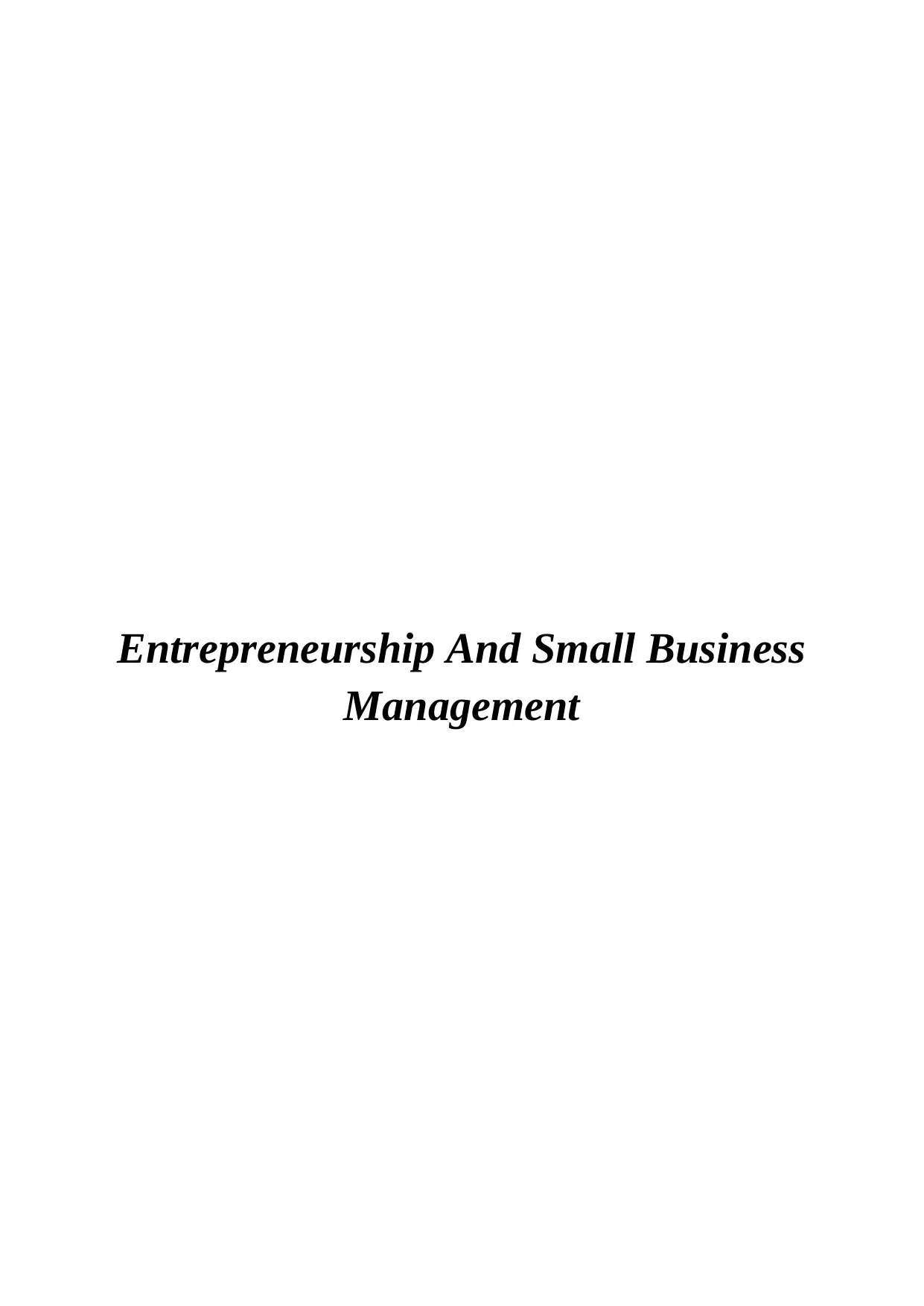
Entrepreneurship And Small Business
Management
Management
Secure Best Marks with AI Grader
Need help grading? Try our AI Grader for instant feedback on your assignments.
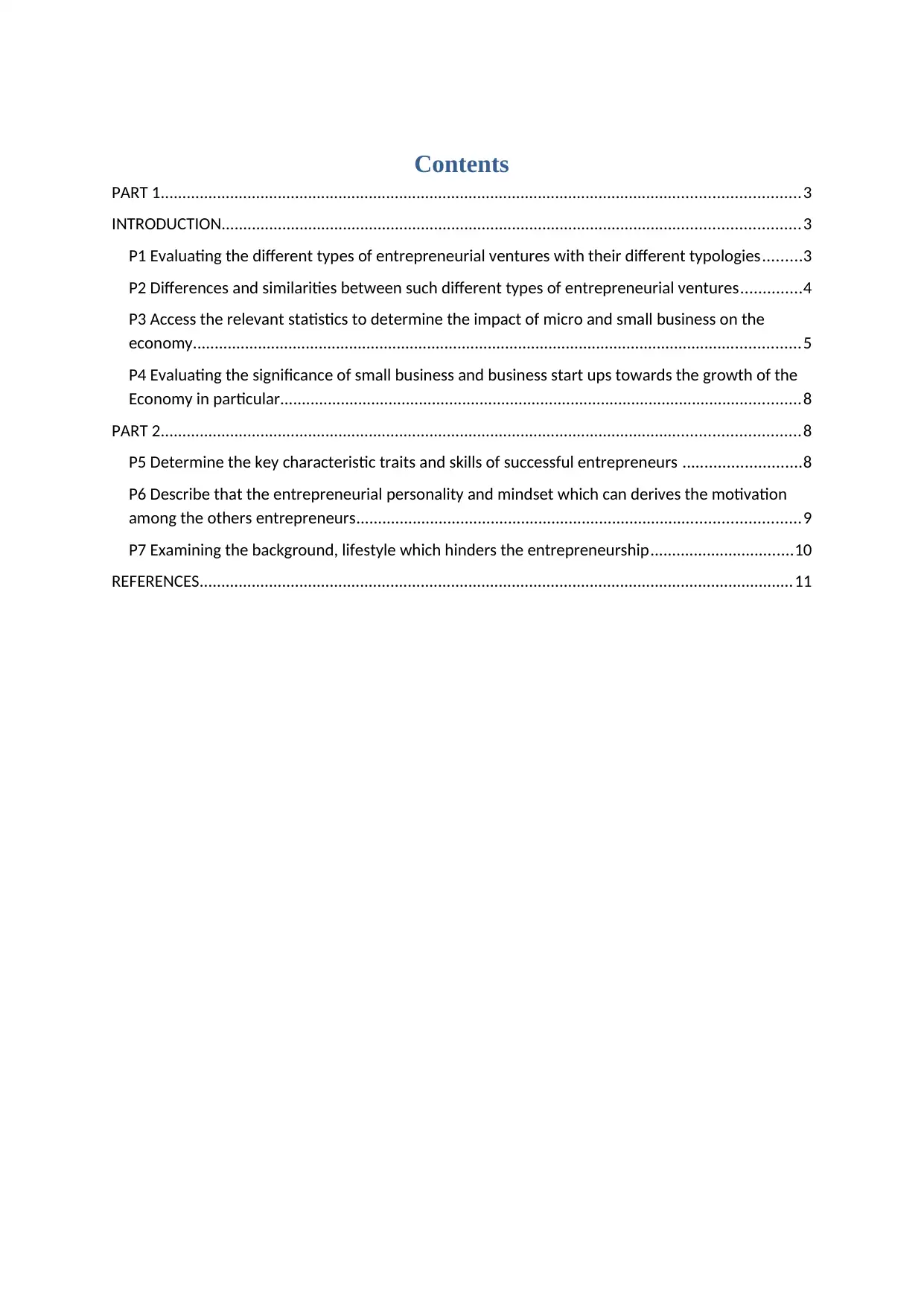
Contents
PART 1...................................................................................................................................................3
INTRODUCTION.....................................................................................................................................3
P1 Evaluating the different types of entrepreneurial ventures with their different typologies.........3
P2 Differences and similarities between such different types of entrepreneurial ventures..............4
P3 Access the relevant statistics to determine the impact of micro and small business on the
economy............................................................................................................................................5
P4 Evaluating the significance of small business and business start ups towards the growth of the
Economy in particular........................................................................................................................8
PART 2...................................................................................................................................................8
P5 Determine the key characteristic traits and skills of successful entrepreneurs ...........................8
P6 Describe that the entrepreneurial personality and mindset which can derives the motivation
among the others entrepreneurs......................................................................................................9
P7 Examining the background, lifestyle which hinders the entrepreneurship.................................10
REFERENCES.........................................................................................................................................11
PART 1...................................................................................................................................................3
INTRODUCTION.....................................................................................................................................3
P1 Evaluating the different types of entrepreneurial ventures with their different typologies.........3
P2 Differences and similarities between such different types of entrepreneurial ventures..............4
P3 Access the relevant statistics to determine the impact of micro and small business on the
economy............................................................................................................................................5
P4 Evaluating the significance of small business and business start ups towards the growth of the
Economy in particular........................................................................................................................8
PART 2...................................................................................................................................................8
P5 Determine the key characteristic traits and skills of successful entrepreneurs ...........................8
P6 Describe that the entrepreneurial personality and mindset which can derives the motivation
among the others entrepreneurs......................................................................................................9
P7 Examining the background, lifestyle which hinders the entrepreneurship.................................10
REFERENCES.........................................................................................................................................11
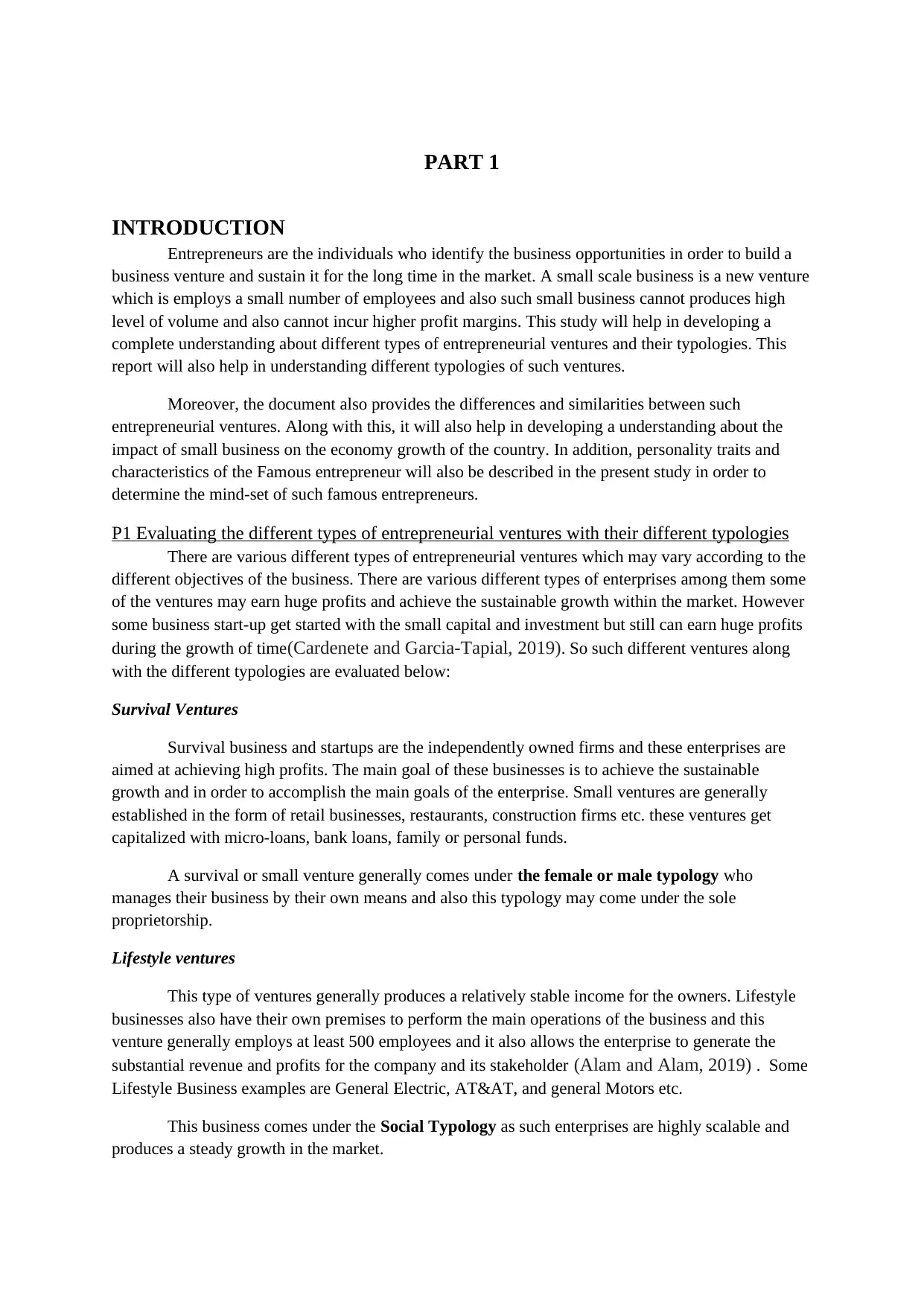
PART 1
INTRODUCTION
Entrepreneurs are the individuals who identify the business opportunities in order to build a
business venture and sustain it for the long time in the market. A small scale business is a new venture
which is employs a small number of employees and also such small business cannot produces high
level of volume and also cannot incur higher profit margins. This study will help in developing a
complete understanding about different types of entrepreneurial ventures and their typologies. This
report will also help in understanding different typologies of such ventures.
Moreover, the document also provides the differences and similarities between such
entrepreneurial ventures. Along with this, it will also help in developing a understanding about the
impact of small business on the economy growth of the country. In addition, personality traits and
characteristics of the Famous entrepreneur will also be described in the present study in order to
determine the mind-set of such famous entrepreneurs.
P1 Evaluating the different types of entrepreneurial ventures with their different typologies
There are various different types of entrepreneurial ventures which may vary according to the
different objectives of the business. There are various different types of enterprises among them some
of the ventures may earn huge profits and achieve the sustainable growth within the market. However
some business start-up get started with the small capital and investment but still can earn huge profits
during the growth of time(Cardenete and Garcia-Tapial, 2019). So such different ventures along
with the different typologies are evaluated below:
Survival Ventures
Survival business and startups are the independently owned firms and these enterprises are
aimed at achieving high profits. The main goal of these businesses is to achieve the sustainable
growth and in order to accomplish the main goals of the enterprise. Small ventures are generally
established in the form of retail businesses, restaurants, construction firms etc. these ventures get
capitalized with micro-loans, bank loans, family or personal funds.
A survival or small venture generally comes under the female or male typology who
manages their business by their own means and also this typology may come under the sole
proprietorship.
Lifestyle ventures
This type of ventures generally produces a relatively stable income for the owners. Lifestyle
businesses also have their own premises to perform the main operations of the business and this
venture generally employs at least 500 employees and it also allows the enterprise to generate the
substantial revenue and profits for the company and its stakeholder (Alam and Alam, 2019) . Some
Lifestyle Business examples are General Electric, AT&AT, and general Motors etc.
This business comes under the Social Typology as such enterprises are highly scalable and
produces a steady growth in the market.
INTRODUCTION
Entrepreneurs are the individuals who identify the business opportunities in order to build a
business venture and sustain it for the long time in the market. A small scale business is a new venture
which is employs a small number of employees and also such small business cannot produces high
level of volume and also cannot incur higher profit margins. This study will help in developing a
complete understanding about different types of entrepreneurial ventures and their typologies. This
report will also help in understanding different typologies of such ventures.
Moreover, the document also provides the differences and similarities between such
entrepreneurial ventures. Along with this, it will also help in developing a understanding about the
impact of small business on the economy growth of the country. In addition, personality traits and
characteristics of the Famous entrepreneur will also be described in the present study in order to
determine the mind-set of such famous entrepreneurs.
P1 Evaluating the different types of entrepreneurial ventures with their different typologies
There are various different types of entrepreneurial ventures which may vary according to the
different objectives of the business. There are various different types of enterprises among them some
of the ventures may earn huge profits and achieve the sustainable growth within the market. However
some business start-up get started with the small capital and investment but still can earn huge profits
during the growth of time(Cardenete and Garcia-Tapial, 2019). So such different ventures along
with the different typologies are evaluated below:
Survival Ventures
Survival business and startups are the independently owned firms and these enterprises are
aimed at achieving high profits. The main goal of these businesses is to achieve the sustainable
growth and in order to accomplish the main goals of the enterprise. Small ventures are generally
established in the form of retail businesses, restaurants, construction firms etc. these ventures get
capitalized with micro-loans, bank loans, family or personal funds.
A survival or small venture generally comes under the female or male typology who
manages their business by their own means and also this typology may come under the sole
proprietorship.
Lifestyle ventures
This type of ventures generally produces a relatively stable income for the owners. Lifestyle
businesses also have their own premises to perform the main operations of the business and this
venture generally employs at least 500 employees and it also allows the enterprise to generate the
substantial revenue and profits for the company and its stakeholder (Alam and Alam, 2019) . Some
Lifestyle Business examples are General Electric, AT&AT, and general Motors etc.
This business comes under the Social Typology as such enterprises are highly scalable and
produces a steady growth in the market.
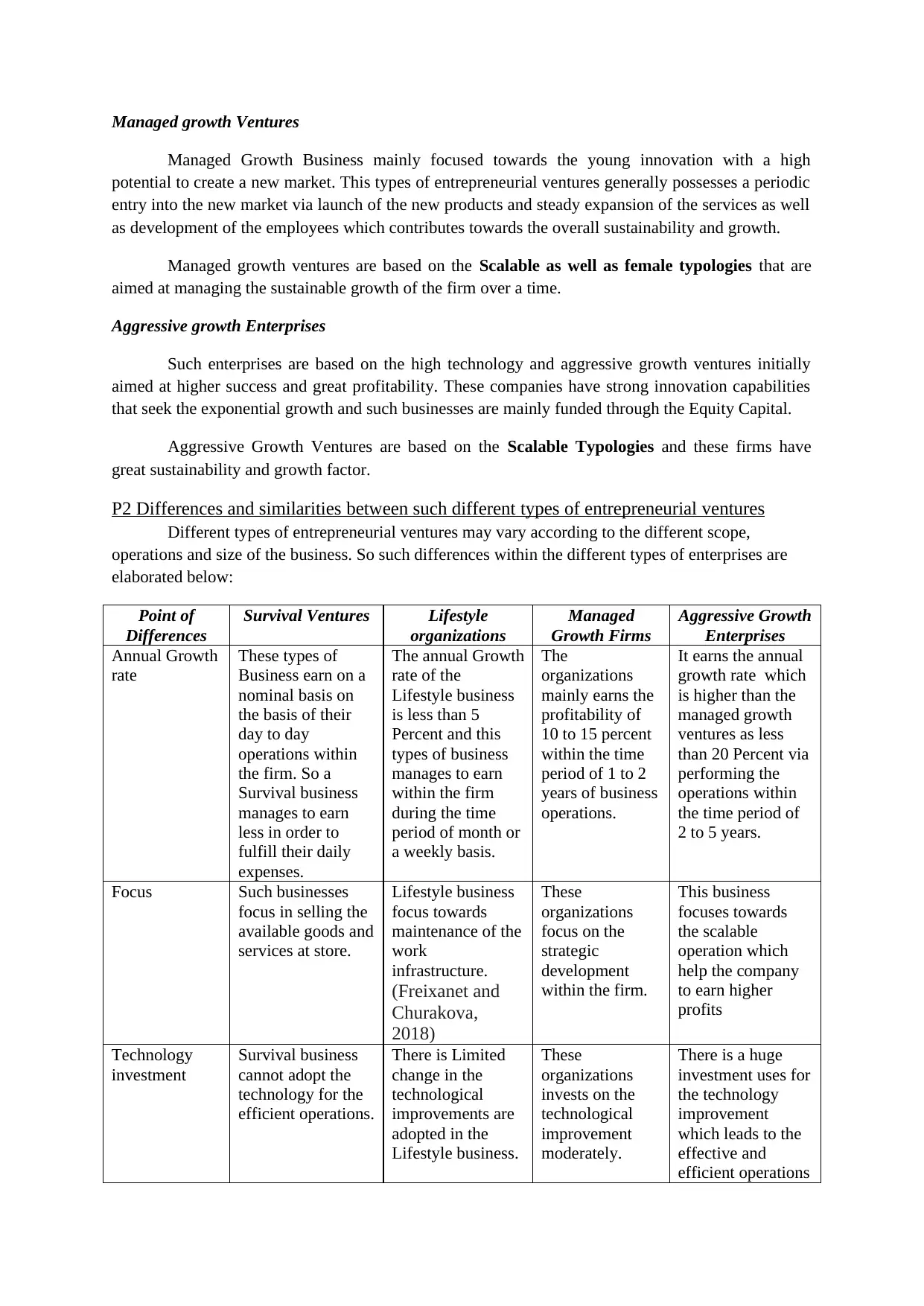
Managed growth Ventures
Managed Growth Business mainly focused towards the young innovation with a high
potential to create a new market. This types of entrepreneurial ventures generally possesses a periodic
entry into the new market via launch of the new products and steady expansion of the services as well
as development of the employees which contributes towards the overall sustainability and growth.
Managed growth ventures are based on the Scalable as well as female typologies that are
aimed at managing the sustainable growth of the firm over a time.
Aggressive growth Enterprises
Such enterprises are based on the high technology and aggressive growth ventures initially
aimed at higher success and great profitability. These companies have strong innovation capabilities
that seek the exponential growth and such businesses are mainly funded through the Equity Capital.
Aggressive Growth Ventures are based on the Scalable Typologies and these firms have
great sustainability and growth factor.
P2 Differences and similarities between such different types of entrepreneurial ventures
Different types of entrepreneurial ventures may vary according to the different scope,
operations and size of the business. So such differences within the different types of enterprises are
elaborated below:
Point of
Differences
Survival Ventures Lifestyle
organizations
Managed
Growth Firms
Aggressive Growth
Enterprises
Annual Growth
rate
These types of
Business earn on a
nominal basis on
the basis of their
day to day
operations within
the firm. So a
Survival business
manages to earn
less in order to
fulfill their daily
expenses.
The annual Growth
rate of the
Lifestyle business
is less than 5
Percent and this
types of business
manages to earn
within the firm
during the time
period of month or
a weekly basis.
The
organizations
mainly earns the
profitability of
10 to 15 percent
within the time
period of 1 to 2
years of business
operations.
It earns the annual
growth rate which
is higher than the
managed growth
ventures as less
than 20 Percent via
performing the
operations within
the time period of
2 to 5 years.
Focus Such businesses
focus in selling the
available goods and
services at store.
Lifestyle business
focus towards
maintenance of the
work
infrastructure.
(Freixanet and
Churakova,
2018)
These
organizations
focus on the
strategic
development
within the firm.
This business
focuses towards
the scalable
operation which
help the company
to earn higher
profits
Technology
investment
Survival business
cannot adopt the
technology for the
efficient operations.
There is Limited
change in the
technological
improvements are
adopted in the
Lifestyle business.
These
organizations
invests on the
technological
improvement
moderately.
There is a huge
investment uses for
the technology
improvement
which leads to the
effective and
efficient operations
Managed Growth Business mainly focused towards the young innovation with a high
potential to create a new market. This types of entrepreneurial ventures generally possesses a periodic
entry into the new market via launch of the new products and steady expansion of the services as well
as development of the employees which contributes towards the overall sustainability and growth.
Managed growth ventures are based on the Scalable as well as female typologies that are
aimed at managing the sustainable growth of the firm over a time.
Aggressive growth Enterprises
Such enterprises are based on the high technology and aggressive growth ventures initially
aimed at higher success and great profitability. These companies have strong innovation capabilities
that seek the exponential growth and such businesses are mainly funded through the Equity Capital.
Aggressive Growth Ventures are based on the Scalable Typologies and these firms have
great sustainability and growth factor.
P2 Differences and similarities between such different types of entrepreneurial ventures
Different types of entrepreneurial ventures may vary according to the different scope,
operations and size of the business. So such differences within the different types of enterprises are
elaborated below:
Point of
Differences
Survival Ventures Lifestyle
organizations
Managed
Growth Firms
Aggressive Growth
Enterprises
Annual Growth
rate
These types of
Business earn on a
nominal basis on
the basis of their
day to day
operations within
the firm. So a
Survival business
manages to earn
less in order to
fulfill their daily
expenses.
The annual Growth
rate of the
Lifestyle business
is less than 5
Percent and this
types of business
manages to earn
within the firm
during the time
period of month or
a weekly basis.
The
organizations
mainly earns the
profitability of
10 to 15 percent
within the time
period of 1 to 2
years of business
operations.
It earns the annual
growth rate which
is higher than the
managed growth
ventures as less
than 20 Percent via
performing the
operations within
the time period of
2 to 5 years.
Focus Such businesses
focus in selling the
available goods and
services at store.
Lifestyle business
focus towards
maintenance of the
work
infrastructure.
(Freixanet and
Churakova,
2018)
These
organizations
focus on the
strategic
development
within the firm.
This business
focuses towards
the scalable
operation which
help the company
to earn higher
profits
Technology
investment
Survival business
cannot adopt the
technology for the
efficient operations.
There is Limited
change in the
technological
improvements are
adopted in the
Lifestyle business.
These
organizations
invests on the
technological
improvement
moderately.
There is a huge
investment uses for
the technology
improvement
which leads to the
effective and
efficient operations
Secure Best Marks with AI Grader
Need help grading? Try our AI Grader for instant feedback on your assignments.
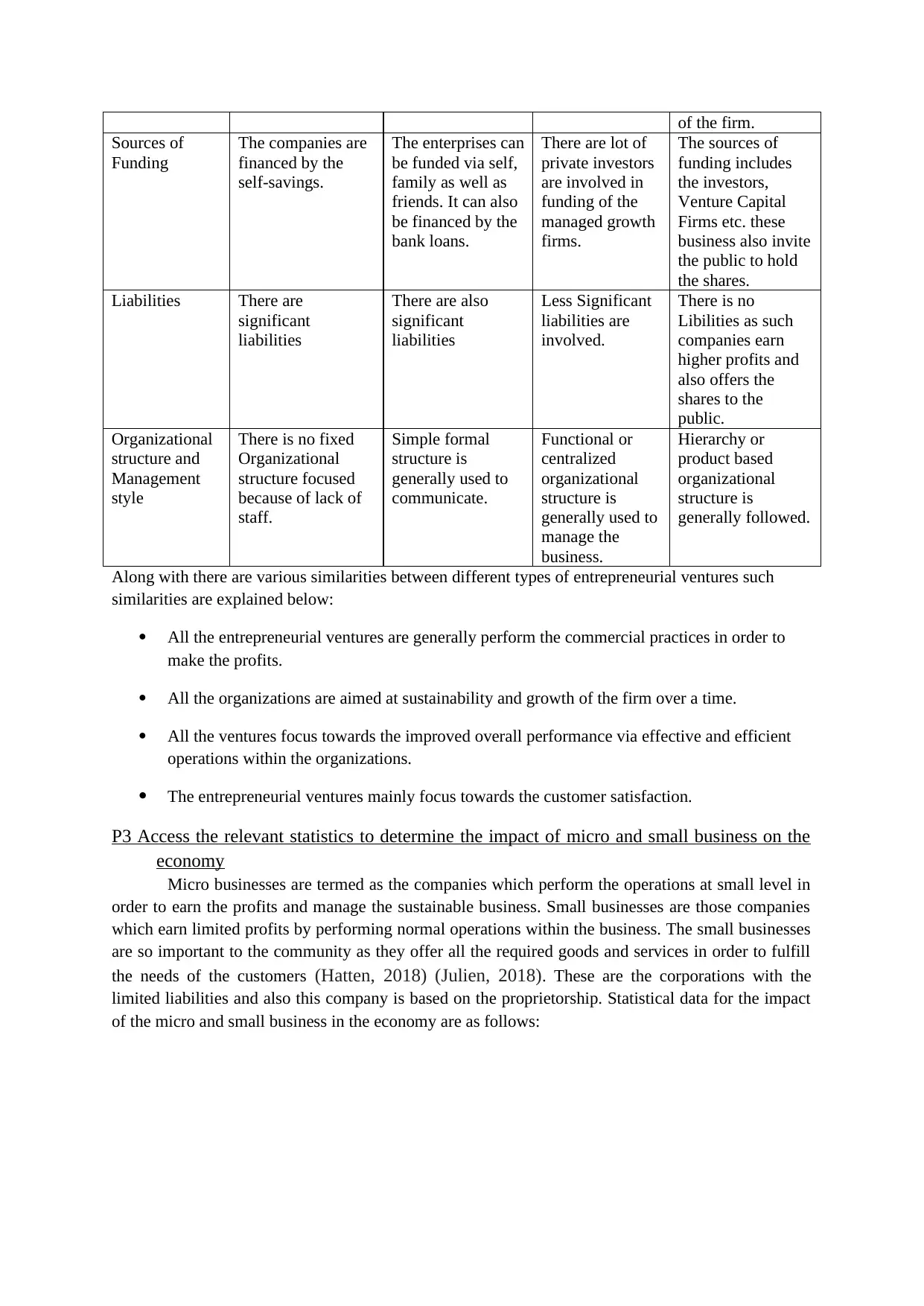
of the firm.
Sources of
Funding
The companies are
financed by the
self-savings.
The enterprises can
be funded via self,
family as well as
friends. It can also
be financed by the
bank loans.
There are lot of
private investors
are involved in
funding of the
managed growth
firms.
The sources of
funding includes
the investors,
Venture Capital
Firms etc. these
business also invite
the public to hold
the shares.
Liabilities There are
significant
liabilities
There are also
significant
liabilities
Less Significant
liabilities are
involved.
There is no
Libilities as such
companies earn
higher profits and
also offers the
shares to the
public.
Organizational
structure and
Management
style
There is no fixed
Organizational
structure focused
because of lack of
staff.
Simple formal
structure is
generally used to
communicate.
Functional or
centralized
organizational
structure is
generally used to
manage the
business.
Hierarchy or
product based
organizational
structure is
generally followed.
Along with there are various similarities between different types of entrepreneurial ventures such
similarities are explained below:
All the entrepreneurial ventures are generally perform the commercial practices in order to
make the profits.
All the organizations are aimed at sustainability and growth of the firm over a time.
All the ventures focus towards the improved overall performance via effective and efficient
operations within the organizations.
The entrepreneurial ventures mainly focus towards the customer satisfaction.
P3 Access the relevant statistics to determine the impact of micro and small business on the
economy
Micro businesses are termed as the companies which perform the operations at small level in
order to earn the profits and manage the sustainable business. Small businesses are those companies
which earn limited profits by performing normal operations within the business. The small businesses
are so important to the community as they offer all the required goods and services in order to fulfill
the needs of the customers (Hatten, 2018) (Julien, 2018). These are the corporations with the
limited liabilities and also this company is based on the proprietorship. Statistical data for the impact
of the micro and small business in the economy are as follows:
Sources of
Funding
The companies are
financed by the
self-savings.
The enterprises can
be funded via self,
family as well as
friends. It can also
be financed by the
bank loans.
There are lot of
private investors
are involved in
funding of the
managed growth
firms.
The sources of
funding includes
the investors,
Venture Capital
Firms etc. these
business also invite
the public to hold
the shares.
Liabilities There are
significant
liabilities
There are also
significant
liabilities
Less Significant
liabilities are
involved.
There is no
Libilities as such
companies earn
higher profits and
also offers the
shares to the
public.
Organizational
structure and
Management
style
There is no fixed
Organizational
structure focused
because of lack of
staff.
Simple formal
structure is
generally used to
communicate.
Functional or
centralized
organizational
structure is
generally used to
manage the
business.
Hierarchy or
product based
organizational
structure is
generally followed.
Along with there are various similarities between different types of entrepreneurial ventures such
similarities are explained below:
All the entrepreneurial ventures are generally perform the commercial practices in order to
make the profits.
All the organizations are aimed at sustainability and growth of the firm over a time.
All the ventures focus towards the improved overall performance via effective and efficient
operations within the organizations.
The entrepreneurial ventures mainly focus towards the customer satisfaction.
P3 Access the relevant statistics to determine the impact of micro and small business on the
economy
Micro businesses are termed as the companies which perform the operations at small level in
order to earn the profits and manage the sustainable business. Small businesses are those companies
which earn limited profits by performing normal operations within the business. The small businesses
are so important to the community as they offer all the required goods and services in order to fulfill
the needs of the customers (Hatten, 2018) (Julien, 2018). These are the corporations with the
limited liabilities and also this company is based on the proprietorship. Statistical data for the impact
of the micro and small business in the economy are as follows:
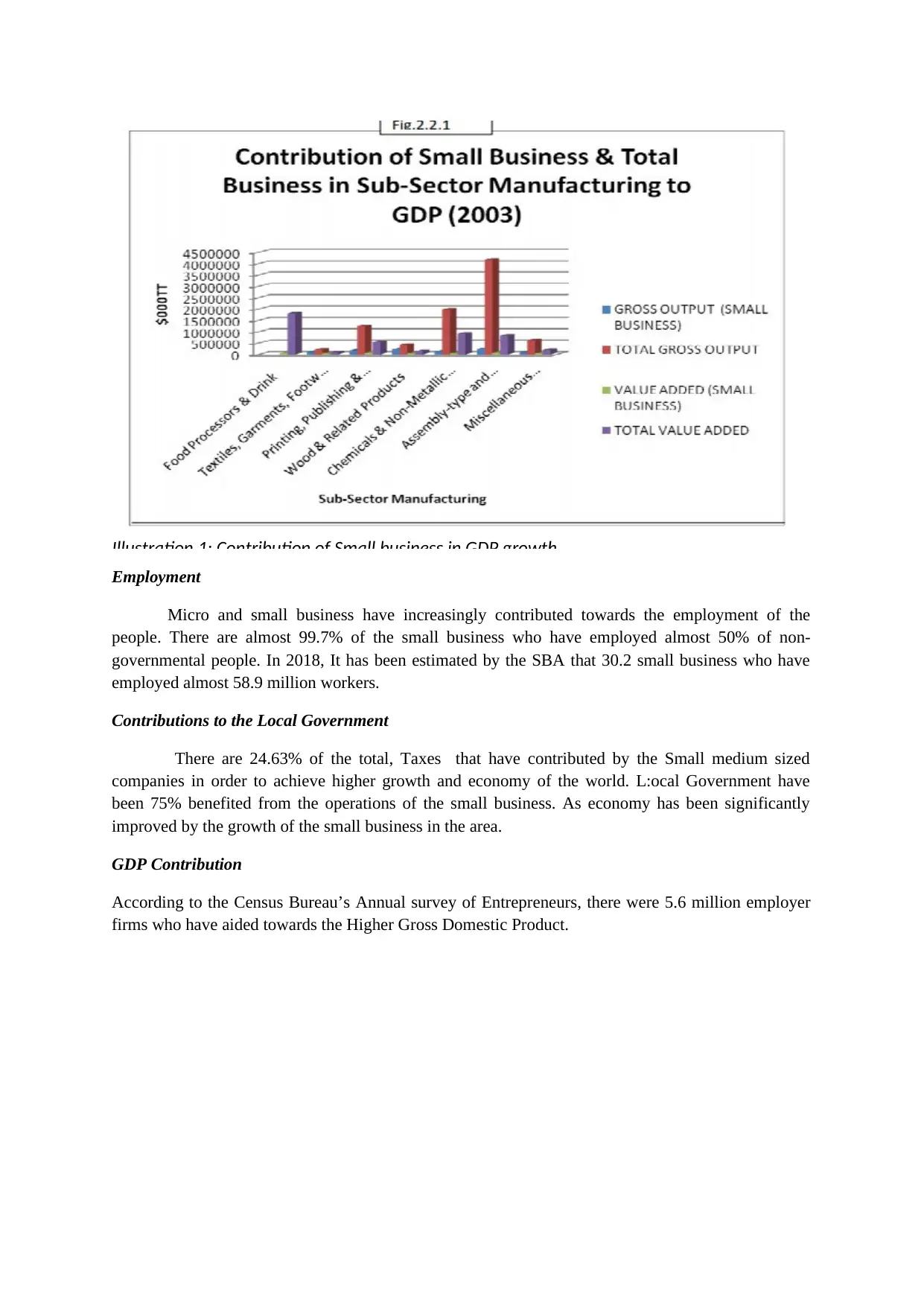
Illustration 1: Contribution of Small business in GDP growth
Employment
Micro and small business have increasingly contributed towards the employment of the
people. There are almost 99.7% of the small business who have employed almost 50% of non-
governmental people. In 2018, It has been estimated by the SBA that 30.2 small business who have
employed almost 58.9 million workers.
Contributions to the Local Government
There are 24.63% of the total, Taxes that have contributed by the Small medium sized
companies in order to achieve higher growth and economy of the world. L:ocal Government have
been 75% benefited from the operations of the small business. As economy has been significantly
improved by the growth of the small business in the area.
GDP Contribution
According to the Census Bureau’s Annual survey of Entrepreneurs, there were 5.6 million employer
firms who have aided towards the Higher Gross Domestic Product.
Employment
Micro and small business have increasingly contributed towards the employment of the
people. There are almost 99.7% of the small business who have employed almost 50% of non-
governmental people. In 2018, It has been estimated by the SBA that 30.2 small business who have
employed almost 58.9 million workers.
Contributions to the Local Government
There are 24.63% of the total, Taxes that have contributed by the Small medium sized
companies in order to achieve higher growth and economy of the world. L:ocal Government have
been 75% benefited from the operations of the small business. As economy has been significantly
improved by the growth of the small business in the area.
GDP Contribution
According to the Census Bureau’s Annual survey of Entrepreneurs, there were 5.6 million employer
firms who have aided towards the Higher Gross Domestic Product.
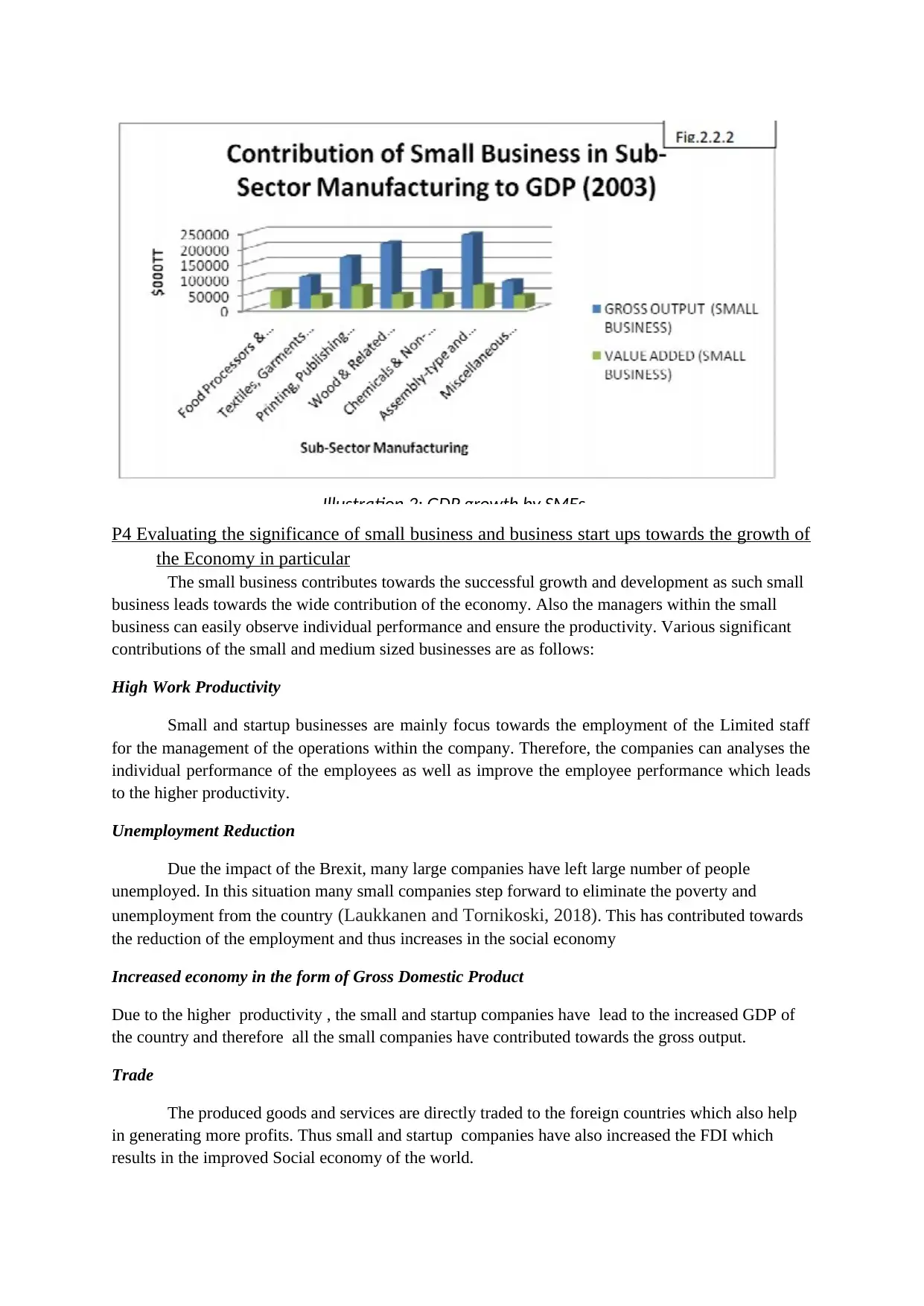
Illustration 2: GDP growth by SMEs
P4 Evaluating the significance of small business and business start ups towards the growth of
the Economy in particular
The small business contributes towards the successful growth and development as such small
business leads towards the wide contribution of the economy. Also the managers within the small
business can easily observe individual performance and ensure the productivity. Various significant
contributions of the small and medium sized businesses are as follows:
High Work Productivity
Small and startup businesses are mainly focus towards the employment of the Limited staff
for the management of the operations within the company. Therefore, the companies can analyses the
individual performance of the employees as well as improve the employee performance which leads
to the higher productivity.
Unemployment Reduction
Due the impact of the Brexit, many large companies have left large number of people
unemployed. In this situation many small companies step forward to eliminate the poverty and
unemployment from the country (Laukkanen and Tornikoski, 2018). This has contributed towards
the reduction of the employment and thus increases in the social economy
Increased economy in the form of Gross Domestic Product
Due to the higher productivity , the small and startup companies have lead to the increased GDP of
the country and therefore all the small companies have contributed towards the gross output.
Trade
The produced goods and services are directly traded to the foreign countries which also help
in generating more profits. Thus small and startup companies have also increased the FDI which
results in the improved Social economy of the world.
P4 Evaluating the significance of small business and business start ups towards the growth of
the Economy in particular
The small business contributes towards the successful growth and development as such small
business leads towards the wide contribution of the economy. Also the managers within the small
business can easily observe individual performance and ensure the productivity. Various significant
contributions of the small and medium sized businesses are as follows:
High Work Productivity
Small and startup businesses are mainly focus towards the employment of the Limited staff
for the management of the operations within the company. Therefore, the companies can analyses the
individual performance of the employees as well as improve the employee performance which leads
to the higher productivity.
Unemployment Reduction
Due the impact of the Brexit, many large companies have left large number of people
unemployed. In this situation many small companies step forward to eliminate the poverty and
unemployment from the country (Laukkanen and Tornikoski, 2018). This has contributed towards
the reduction of the employment and thus increases in the social economy
Increased economy in the form of Gross Domestic Product
Due to the higher productivity , the small and startup companies have lead to the increased GDP of
the country and therefore all the small companies have contributed towards the gross output.
Trade
The produced goods and services are directly traded to the foreign countries which also help
in generating more profits. Thus small and startup companies have also increased the FDI which
results in the improved Social economy of the world.
Paraphrase This Document
Need a fresh take? Get an instant paraphrase of this document with our AI Paraphraser
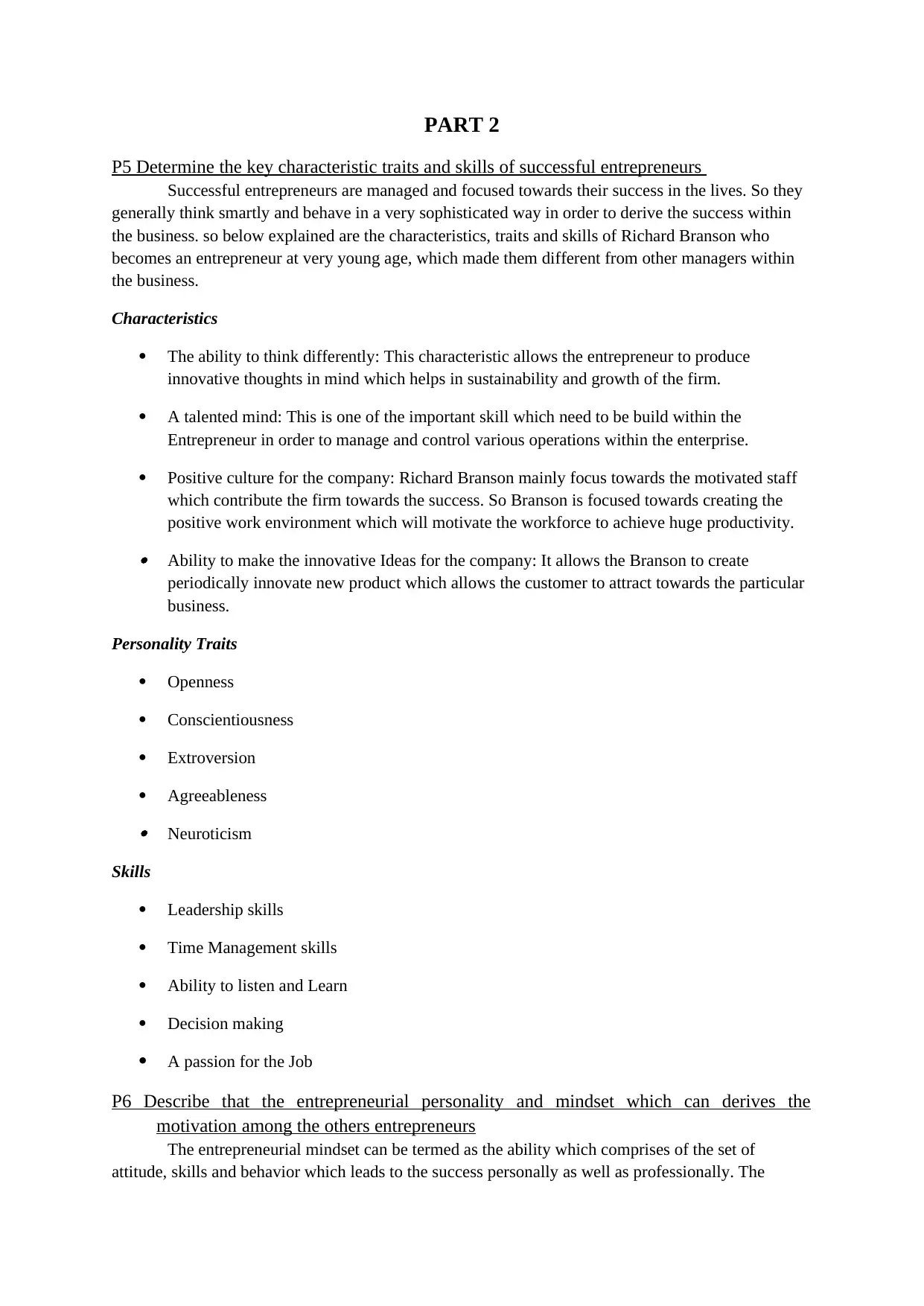
PART 2
P5 Determine the key characteristic traits and skills of successful entrepreneurs
Successful entrepreneurs are managed and focused towards their success in the lives. So they
generally think smartly and behave in a very sophisticated way in order to derive the success within
the business. so below explained are the characteristics, traits and skills of Richard Branson who
becomes an entrepreneur at very young age, which made them different from other managers within
the business.
Characteristics
The ability to think differently: This characteristic allows the entrepreneur to produce
innovative thoughts in mind which helps in sustainability and growth of the firm.
A talented mind: This is one of the important skill which need to be build within the
Entrepreneur in order to manage and control various operations within the enterprise.
Positive culture for the company: Richard Branson mainly focus towards the motivated staff
which contribute the firm towards the success. So Branson is focused towards creating the
positive work environment which will motivate the workforce to achieve huge productivity. Ability to make the innovative Ideas for the company: It allows the Branson to create
periodically innovate new product which allows the customer to attract towards the particular
business.
Personality Traits
Openness
Conscientiousness
Extroversion
Agreeableness Neuroticism
Skills
Leadership skills
Time Management skills
Ability to listen and Learn
Decision making
A passion for the Job
P6 Describe that the entrepreneurial personality and mindset which can derives the
motivation among the others entrepreneurs
The entrepreneurial mindset can be termed as the ability which comprises of the set of
attitude, skills and behavior which leads to the success personally as well as professionally. The
P5 Determine the key characteristic traits and skills of successful entrepreneurs
Successful entrepreneurs are managed and focused towards their success in the lives. So they
generally think smartly and behave in a very sophisticated way in order to derive the success within
the business. so below explained are the characteristics, traits and skills of Richard Branson who
becomes an entrepreneur at very young age, which made them different from other managers within
the business.
Characteristics
The ability to think differently: This characteristic allows the entrepreneur to produce
innovative thoughts in mind which helps in sustainability and growth of the firm.
A talented mind: This is one of the important skill which need to be build within the
Entrepreneur in order to manage and control various operations within the enterprise.
Positive culture for the company: Richard Branson mainly focus towards the motivated staff
which contribute the firm towards the success. So Branson is focused towards creating the
positive work environment which will motivate the workforce to achieve huge productivity. Ability to make the innovative Ideas for the company: It allows the Branson to create
periodically innovate new product which allows the customer to attract towards the particular
business.
Personality Traits
Openness
Conscientiousness
Extroversion
Agreeableness Neuroticism
Skills
Leadership skills
Time Management skills
Ability to listen and Learn
Decision making
A passion for the Job
P6 Describe that the entrepreneurial personality and mindset which can derives the
motivation among the others entrepreneurs
The entrepreneurial mindset can be termed as the ability which comprises of the set of
attitude, skills and behavior which leads to the success personally as well as professionally. The
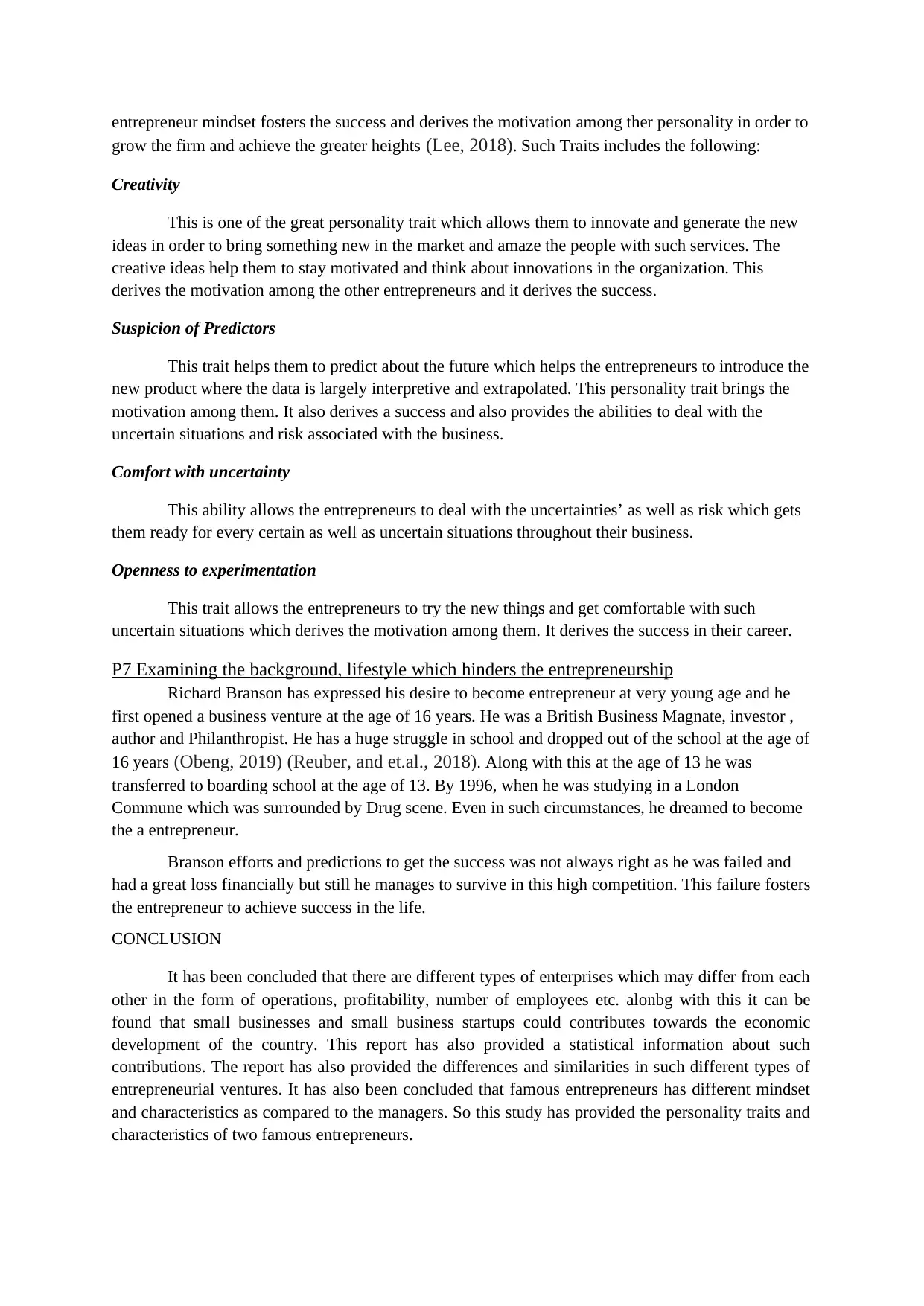
entrepreneur mindset fosters the success and derives the motivation among ther personality in order to
grow the firm and achieve the greater heights (Lee, 2018). Such Traits includes the following:
Creativity
This is one of the great personality trait which allows them to innovate and generate the new
ideas in order to bring something new in the market and amaze the people with such services. The
creative ideas help them to stay motivated and think about innovations in the organization. This
derives the motivation among the other entrepreneurs and it derives the success.
Suspicion of Predictors
This trait helps them to predict about the future which helps the entrepreneurs to introduce the
new product where the data is largely interpretive and extrapolated. This personality trait brings the
motivation among them. It also derives a success and also provides the abilities to deal with the
uncertain situations and risk associated with the business.
Comfort with uncertainty
This ability allows the entrepreneurs to deal with the uncertainties’ as well as risk which gets
them ready for every certain as well as uncertain situations throughout their business.
Openness to experimentation
This trait allows the entrepreneurs to try the new things and get comfortable with such
uncertain situations which derives the motivation among them. It derives the success in their career.
P7 Examining the background, lifestyle which hinders the entrepreneurship
Richard Branson has expressed his desire to become entrepreneur at very young age and he
first opened a business venture at the age of 16 years. He was a British Business Magnate, investor ,
author and Philanthropist. He has a huge struggle in school and dropped out of the school at the age of
16 years (Obeng, 2019) (Reuber, and et.al., 2018). Along with this at the age of 13 he was
transferred to boarding school at the age of 13. By 1996, when he was studying in a London
Commune which was surrounded by Drug scene. Even in such circumstances, he dreamed to become
the a entrepreneur.
Branson efforts and predictions to get the success was not always right as he was failed and
had a great loss financially but still he manages to survive in this high competition. This failure fosters
the entrepreneur to achieve success in the life.
CONCLUSION
It has been concluded that there are different types of enterprises which may differ from each
other in the form of operations, profitability, number of employees etc. alonbg with this it can be
found that small businesses and small business startups could contributes towards the economic
development of the country. This report has also provided a statistical information about such
contributions. The report has also provided the differences and similarities in such different types of
entrepreneurial ventures. It has also been concluded that famous entrepreneurs has different mindset
and characteristics as compared to the managers. So this study has provided the personality traits and
characteristics of two famous entrepreneurs.
grow the firm and achieve the greater heights (Lee, 2018). Such Traits includes the following:
Creativity
This is one of the great personality trait which allows them to innovate and generate the new
ideas in order to bring something new in the market and amaze the people with such services. The
creative ideas help them to stay motivated and think about innovations in the organization. This
derives the motivation among the other entrepreneurs and it derives the success.
Suspicion of Predictors
This trait helps them to predict about the future which helps the entrepreneurs to introduce the
new product where the data is largely interpretive and extrapolated. This personality trait brings the
motivation among them. It also derives a success and also provides the abilities to deal with the
uncertain situations and risk associated with the business.
Comfort with uncertainty
This ability allows the entrepreneurs to deal with the uncertainties’ as well as risk which gets
them ready for every certain as well as uncertain situations throughout their business.
Openness to experimentation
This trait allows the entrepreneurs to try the new things and get comfortable with such
uncertain situations which derives the motivation among them. It derives the success in their career.
P7 Examining the background, lifestyle which hinders the entrepreneurship
Richard Branson has expressed his desire to become entrepreneur at very young age and he
first opened a business venture at the age of 16 years. He was a British Business Magnate, investor ,
author and Philanthropist. He has a huge struggle in school and dropped out of the school at the age of
16 years (Obeng, 2019) (Reuber, and et.al., 2018). Along with this at the age of 13 he was
transferred to boarding school at the age of 13. By 1996, when he was studying in a London
Commune which was surrounded by Drug scene. Even in such circumstances, he dreamed to become
the a entrepreneur.
Branson efforts and predictions to get the success was not always right as he was failed and
had a great loss financially but still he manages to survive in this high competition. This failure fosters
the entrepreneur to achieve success in the life.
CONCLUSION
It has been concluded that there are different types of enterprises which may differ from each
other in the form of operations, profitability, number of employees etc. alonbg with this it can be
found that small businesses and small business startups could contributes towards the economic
development of the country. This report has also provided a statistical information about such
contributions. The report has also provided the differences and similarities in such different types of
entrepreneurial ventures. It has also been concluded that famous entrepreneurs has different mindset
and characteristics as compared to the managers. So this study has provided the personality traits and
characteristics of two famous entrepreneurs.

Secure Best Marks with AI Grader
Need help grading? Try our AI Grader for instant feedback on your assignments.
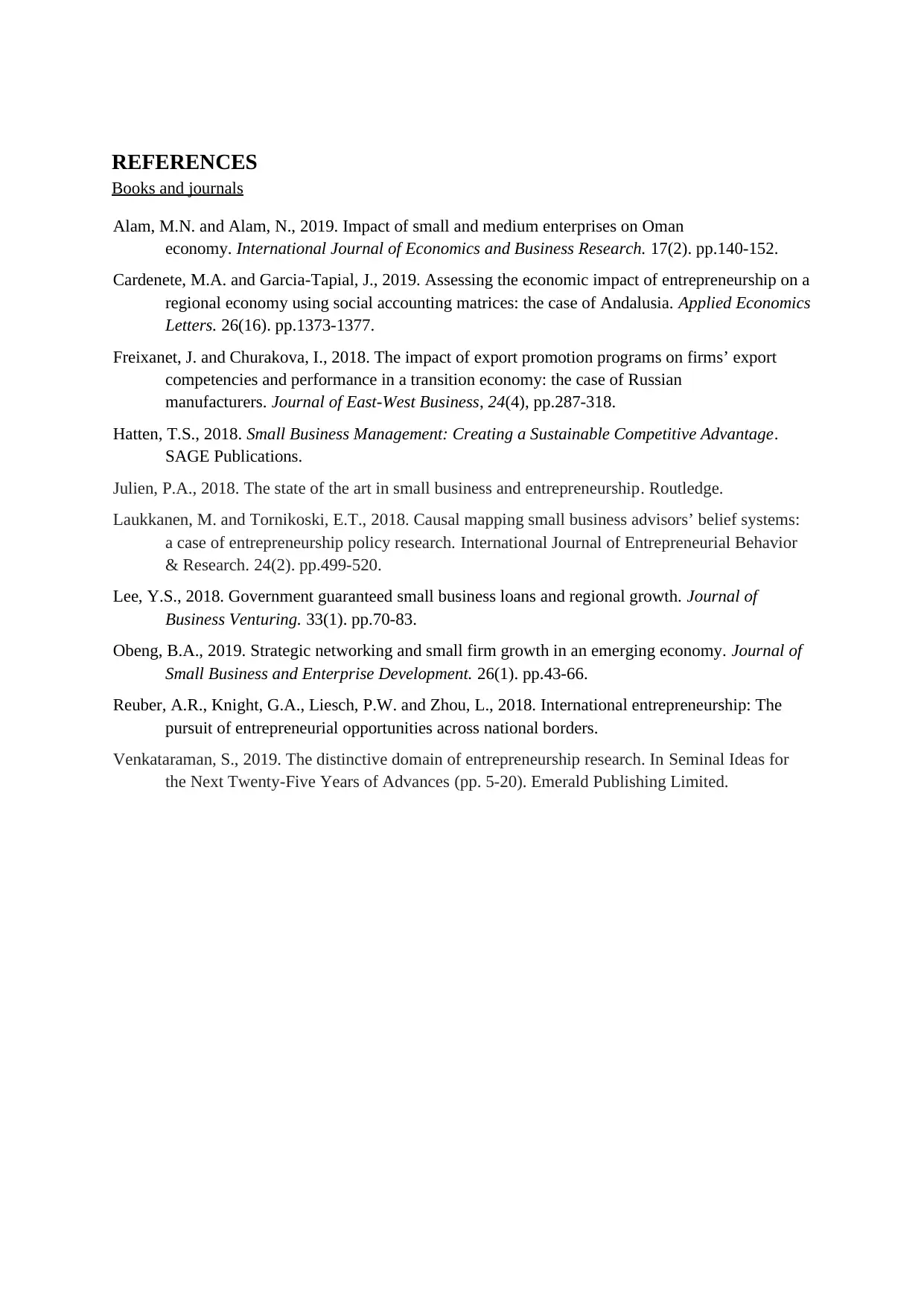
REFERENCES
Books and journals
Alam, M.N. and Alam, N., 2019. Impact of small and medium enterprises on Oman
economy. International Journal of Economics and Business Research. 17(2). pp.140-152.
Cardenete, M.A. and Garcia-Tapial, J., 2019. Assessing the economic impact of entrepreneurship on a
regional economy using social accounting matrices: the case of Andalusia. Applied Economics
Letters. 26(16). pp.1373-1377.
Freixanet, J. and Churakova, I., 2018. The impact of export promotion programs on firms’ export
competencies and performance in a transition economy: the case of Russian
manufacturers. Journal of East-West Business, 24(4), pp.287-318.
Hatten, T.S., 2018. Small Business Management: Creating a Sustainable Competitive Advantage.
SAGE Publications.
Julien, P.A., 2018. The state of the art in small business and entrepreneurship. Routledge.
Laukkanen, M. and Tornikoski, E.T., 2018. Causal mapping small business advisors’ belief systems:
a case of entrepreneurship policy research. International Journal of Entrepreneurial Behavior
& Research. 24(2). pp.499-520.
Lee, Y.S., 2018. Government guaranteed small business loans and regional growth. Journal of
Business Venturing. 33(1). pp.70-83.
Obeng, B.A., 2019. Strategic networking and small firm growth in an emerging economy. Journal of
Small Business and Enterprise Development. 26(1). pp.43-66.
Reuber, A.R., Knight, G.A., Liesch, P.W. and Zhou, L., 2018. International entrepreneurship: The
pursuit of entrepreneurial opportunities across national borders.
Venkataraman, S., 2019. The distinctive domain of entrepreneurship research. In Seminal Ideas for
the Next Twenty-Five Years of Advances (pp. 5-20). Emerald Publishing Limited.
Books and journals
Alam, M.N. and Alam, N., 2019. Impact of small and medium enterprises on Oman
economy. International Journal of Economics and Business Research. 17(2). pp.140-152.
Cardenete, M.A. and Garcia-Tapial, J., 2019. Assessing the economic impact of entrepreneurship on a
regional economy using social accounting matrices: the case of Andalusia. Applied Economics
Letters. 26(16). pp.1373-1377.
Freixanet, J. and Churakova, I., 2018. The impact of export promotion programs on firms’ export
competencies and performance in a transition economy: the case of Russian
manufacturers. Journal of East-West Business, 24(4), pp.287-318.
Hatten, T.S., 2018. Small Business Management: Creating a Sustainable Competitive Advantage.
SAGE Publications.
Julien, P.A., 2018. The state of the art in small business and entrepreneurship. Routledge.
Laukkanen, M. and Tornikoski, E.T., 2018. Causal mapping small business advisors’ belief systems:
a case of entrepreneurship policy research. International Journal of Entrepreneurial Behavior
& Research. 24(2). pp.499-520.
Lee, Y.S., 2018. Government guaranteed small business loans and regional growth. Journal of
Business Venturing. 33(1). pp.70-83.
Obeng, B.A., 2019. Strategic networking and small firm growth in an emerging economy. Journal of
Small Business and Enterprise Development. 26(1). pp.43-66.
Reuber, A.R., Knight, G.A., Liesch, P.W. and Zhou, L., 2018. International entrepreneurship: The
pursuit of entrepreneurial opportunities across national borders.
Venkataraman, S., 2019. The distinctive domain of entrepreneurship research. In Seminal Ideas for
the Next Twenty-Five Years of Advances (pp. 5-20). Emerald Publishing Limited.

1 out of 12
Related Documents
Your All-in-One AI-Powered Toolkit for Academic Success.
+13062052269
info@desklib.com
Available 24*7 on WhatsApp / Email
![[object Object]](/_next/static/media/star-bottom.7253800d.svg)
Unlock your academic potential
© 2024 | Zucol Services PVT LTD | All rights reserved.





